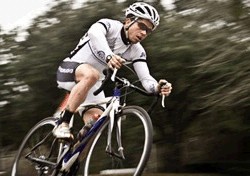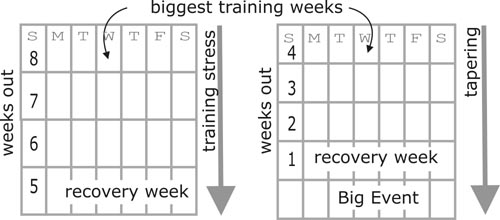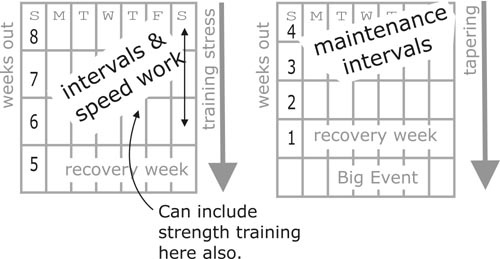Arizona Brevet & Randonnee
Home of Arizona Brevets and Long Distance Cycling
|
Author & Coach Jeb Stewart Jeb Stewart is an elite cycling coach, strength and conditioning specialist, nutritional expert and avid bike racer. He is the head coach of the Gearlink Racing Team and owner of Endurofit LLC, a coaching and consulting business dedicated to performance enhancement and wellness promotion for athletes of all levels and abilities. Find out more by visiting his web site at Endurofit.com or follow Jeb on Facebook, Twitter and his blog. Get his FREE Sprinting 101 e-book and FREE training tips. |
|
How to Peak for Your Randonnee |
|
by Jeb Stewart MS, CSCS Effective training, regardless of the discipline, requires an intelligently periodized approach designed to bring the athlete to a peak of fitness just in time for the desired event. This is true for most sports and includes ultra-cycling. In a sport where the physical, mental, emotional, financial and time demands are quite high, it is even more imperative that we make sure that what we are doing in training is effectively guiding us towards where we want to go. Our training should be designed to have us at our peak of endurance, strength and speed just in time for our goal event. We also need to be mentally ready as well and should limit the amount of fatigue we carry into it. This article will discuss exactly what peaking means, what it entails and how to go about coming to a peak for an ultra-cycling event. For the purpose of this discussion it will be assumed that the rider is two months out from the event and has done the requisite base volume to prepare the rider effectively for a big ultra event such as Boston-Montreal-Boston or Paris-Brest-Paris. Peaking Defined Before we can aim at a peak we should discuss what a peak is. If you have to ask, then you have probably never experienced one and if you have then you already know. A peak in fitness is probably the best feeling you have ever had on the bike. When you are experiencing a peak, riding your bike feels almost effortless. Your power, endurance, speed and form are all at their best at exactly the right time. Fatigue comes extremely late in a ride if at all and you feel light on the pedals, glad to be on the bike and faster, stronger and smoother than ever before. Technically, a peak in fitness is achieved as the result of methodical preparation, usually from a periodized training program that increases the training stress to progressively overload the system. The increased overload is followed by a systematic reduction in volume and duration while maintaining intensity. This allows the rider to adapt to the training, recover and build up the energy to perform optimally on event day. This is an often misunderstood practice and too many athletes think they have to train longer and harder than they actually do, right up to their event, leaving them tired and flat. Training only creates the potential for fitness. For it is when we rest that we actualize it. The Plan Remember, we are assuming that you have your base fitness under your belt. Now it is time to develop the event specific speed you desire and to fine-tune any missing elements in your training program. This can include terrain specific work such as climbing, acclimatizing to the weather conditions and doing speed work in the form of sport-specific intervals. With two months to go until your event you should put in your biggest weeks at the beginning of each of your last two months of training. This will be to allow you to fully recover from and adapt to the training and limit the amount of fatigue you carry into your event. The goal is to get in the training and systematically reduce the amount of residual fatigue before the event.
Interval Training and Speed Work You should start performing some sport-specific intervals to improve your speed as well as doing some training on the terrain that you expect at your event. This will help your body get used to the movement speed and muscle recruitment patterns inherent with the challenge. Intervals typically consist of tempo (Zone 3) intervals to improve your speed while staying aerobic. Intervals can also be muscular endurance work in the form of climbing or lower cadence force intervals to increase your muscular endurance. Harder workouts such as Lactate Threshold (Zone 4) intervals can be substituted for the tempo work by advanced or elite athletes if your goal is to significantly increase your speed and work capacity prior to your event.
Strength and Conditioning If you are doing strength and conditioning work in your training, I recommend continuing it until about four weeks out from your event. It takes about three weeks for the legs to completely adapt their muscle memory to the movement speed inherent with the pedal stroke and to lose the muscle memory of the slower cadence of lifting weights. This will improve your leg speed significantly and you will not lose the gains you have made up to this point. You can continue your core work up until the week of your event and I suggest keeping up with your flexibility work throughout. I suggest ceasing even the core work the week leading into your event to allow your body to use every ounce of its energy for your event. I also recommend avoiding too much stretching after your extremely long training rides and events. Your muscles may be dehydrated, depleted of electrolytes and in a severe state of fatigue afterwards and susceptible to stretch injury. Wait until your event is over to start working on your flexibility again. Recovery As you begin to taper and recover your energy stores heading into your event, do everything you possibly can to assist the body in this endeavor. This includes getting lots of rest, stretching, getting massage, keeping your stress level low, eating right and staying positive. If you do not have a recovery strategy in your program then I highly recommend creating one or consulting with someone to help you develop it. Whether it is off days, easy days, bodywork, visualization or all of the above, making sure to keep recovery a large part of your program is critical to success. What to do If your goal event has a lot of climbing in it, then I highly recommend doing some climbing and/or muscular endurance (force) work one to two times a week leading up to your event. This is especially important from week eight to week five before the event. You can follow this period with more leg speed training to help offset the slower leg speed involved in climbing and even incorporate force specific speed work. I also include some shorter leg speed intervals before and after muscular endurance workouts for the same reason, to begin and end the workout with speed work to help the body remember fast movements. As I said before, start eight weeks out with your longest muscular endurance intervals. These should be no longer than 1/3-1/2 the length of your longest climbs in your upcoming event. If you are well-trained in this area then you can do these as single intervals doing the whole time in the lower cadence ranges inherent with climbing. If you are less trained in this area, then break the intervals up into segments and aim to accumulate 1/2-1/3 of the time of your longest upcoming climb. These can be done in segments of 10, 15, 20 or 30 minutes. Recovery periods should be no less than five minutes and no longer than 10 minutes. Muscular endurance intervals should be performed at 50-70 rpms at an endurance or tempo pace. Try to speed it up a little bit to improve your speed at this intensity. So, try doing them at 60-80 rpms at tempo or threshold pace. Remember to do these in descending duration, doing your longest ones in the first week and decreasing the overall amount of time doing these intervals by 20-25% every week. As an example, if your longest climb on B-M-B will take you two hours, you could start with three 20-minute intervals with 10 minutes recovery (60 minutes = 1/2 of two hours). Over four weeks decrease to three 10-minute intervals with five minutes recovery. If your event involves lots of climbing, then this whole month should be spent doing speed and force work. You can gradually decrease the grade while you decrease the duration, which will have the effect of increasing your speed along the way. If your event is relatively flat to rolling, then employ a similar approach to your intervals, only without the force work. It is important to figure out which category you fall into and shoot for this bench mark in your interval training to develop event specific speed. More highly trained athletes should be able to ride in their tempo range for two hours or more and less trained athletes should be able to ride at tempo pace for at least an hour. If you can ride tempo for two hours, then you can include threshold work to really bump up your work capacity. The advanced athlete should be able to ride at or near threshold for nearly an hour. Tempo pace is the highest end of your sub-threshold aerobic capacity and is not all out, or time trial pace and should be slightly uncomfortable, but not painful. For power training, tempo pace is 76-90% of your lactate threshold power and 84-94% of your lactate threshold HR. Just like doing the force work, speed intervals should progress the same way, doing your longest ones eight weeks out and decreasing them as you get closer to your event. Again, these can be done in one block of one to two hours if you have the fitness, or in smaller blocks of 15, 20 or 30 minutes. Recovery periods should be five to ten minutes and these should be done on flat to rolling terrain. Each week there should be one day completely off, at least one active recovery day and another easy day interspersed between the interval days. Ideally, interval days should fall on Tuesdays and Thursdays and long days on Saturday and/or Sunday. This will allow for maximum recovery between workouts. Workouts during the week don't need to be longer than two hours unless a job is not an issue and the long days on the weekends shouldn't be more than 10 hours. These long and back-to-back days are where you will cut back the most significantly as you get closer and closer to your event. As you move into your last four weeks prior to your event, your long days should be over, except for a couple of three to five hour rides in the first week and one the second. By now you should have all of the endurance you need and fortunately endurance is the last element of fitness to go. We only want to do two interval days in the first week of the month and then cut our speed interval days to once weekly for the second week leading into our peak weeks. These should be focused only speed and be on flat to rolling terrain to maximize the training effect. It is okay to keep at least one day of climbing, ideally on your weekly long day to keep your climbing legs tuned. The other days of training will be recovery or easy endurance pace focused primarily on helping our bodies adapt to the work we have done and allowing time to store up the energy we need to perform at our best. If you are missing anything, the last time you can do anything to improve your fitness significantly is in the first week of the month, four weeks out. Only then will it have time to show up as fitness three weeks later. The rest of the time should be about maintaining, avoiding getting flat, recovering and getting stronger. By the time we get to two weeks from our event, we should focus primarily on resting, recovering, and preparing mentally. This is a good time to go over all of your plans and preparations as well getting in the right place mentally, emotionally and spiritually to perform maximally at your event. Meditation, visualization exercises and journaling are all good techniques to get your internal landscape aligned for success. Your longest ride for the week should be no more than three hours and the rest of them should be easy and no more than one to two hours. You don't need to be on the bike more than three or four days and the rest of your time should be spent stretching, getting the rest you need and eating properly. Be sure to hydrate effectively in the days leading up to your event and take in a few extra complex carbohydrates along with your normal intake of lean proteins and healthy fats. Finally, in the week leading up to your goal event, you should ride easily one to two times for no more than an hour or so and do lots of stretching just to keep your legs open and loose. I recommend taking an off day three days out and the day just before your event to maximally store up the energy required for a peak performance. If you have followed the majority of the recommendations in this article then you will be properly prepared to rock and roll on event day. Stay positive and get excited because you are about to experience your best outing to date.
|


